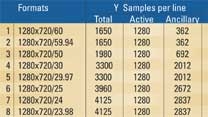The 1280\00d7720/60 HDTV format

The latest (January 4, 2001) revision of SMPTE Standard 296M, 1280×720 Progressive Image Sample Structure - Analog and Digital Representation and Analog Interface, defines a family of eight progressive image sampling systems. The standard covers both GBR and YCBCR formats. There is no ITU counterpart of this standard because at present, ITU does not consider it as an HDTV format.
Table 1. The 1280x720 image sampling formats and some basic characteristics are listed above.
Table 1 lists the members of the family and some basic characteristics. All YCBCR formats have a common image format (CIF). CIF means that all formats have a 16:9 aspect ratio, 1280 active Y horizontal pixels and 720 active scanning lines, irrespective of the frame rate. There is no corresponding ITU standard, but certain signal characteristics, such as the colorimetry and coded signal's matrix coefficients, conform to the ITU 709.
This article will focus on some aspects of the more commonly used 1280×720/60 and 1280×720/59.94 formats. Table 2 shows the picture scanning characteristics of the formats.
The digital representation
Table 3 details the digital representation of the format. The digital coding is based on one luminance, E´Y, and two color-difference, E´CB and E´CR, analog signals. The coded signals matrix coefficients are defined in ITU-R BT.709 and are significantly different from those specified by ITU-R BT.601. The implication here is that format conversion applications require matrixing recalculation.
Table 2. The picture scanning characteristics of the 1280x720/60 format are provided.
Get the TV Tech Newsletter
The professional video industry's #1 source for news, trends and product and tech information. Sign up below.
The luminance sampling frequency of 74.25MHz is obtained from the analog input video sync signal using a phase-locked-loop-controlled oscillator operating at 1650 × fH, resulting in a Nyquist frequency of 37.125MHz. The specified anti-aliasing low-pass filter has a cutoff frequency of 30MHz. The color-difference signals' sampling frequency is 37.25MHz or 825 × fH, resulting in a Nyquist frequency of 18.5625MHz. The specified anti-aliasing low-pass filter has a cutoff frequency of 15MHz. The selected sampling frequencies result in an active line with 1280 Y samples and 640 each CB and CR samples.
As shown in Figure 1, the digital representation assumes two separate bit-parallel datastreams consisting of:
- A digital datastream conveying a digitized luminance bit-parallel signal Y with a data rate of 74.25Mwords/s.
- A digital datastream conveying digitized time-division-multiplexed bit-parallel signals CB and CR with a data rate of 74.25Mwords/s.
Each datastream carries the active video information as well as its own TRS information, end of active video (EAV) and start of active video (SAV), and the ancillary data if present. As shown in Table 1, due to the wide variation of frame rates of the formats, keeping CIF of 1280×720 results in widely differing horizontal blanking intervals and ancillary data spaces.
Table 3. The digital representation of the 1280x720/60 format is illustrated in this figure.
In a 10-bit system, the digital information occupies a range extending from 000h to 3FFh (0 to 1023 decimal). Table 2 shows that the luminance (Y) signal normally extends from black, 040h (64), to white, 3ACh (940). The CB and CR signals normally extend from 040h (64) to 3C0h (960). In order to cater to overshoot and undershoot, the allowed range is extended to 004h to 3FBh (4 to 1019). Values from 000h to 003h (0 to 3) and 3FCh to 3FFh (1020 to 1023) are reserved for TRS signals (EAV and SAV).
The EAV and SAV signals each consist of a 4-word sequence:
- The three synchronizing words with hexadecimal values of, respectively, 3FF, 000 and 000.
- The XYZ word, which carries the V bit, the F bit and the H bit. These bits define the vertical and horizontal blanking. Note that the F bit is always zero, as there are no fields requiring identification. In addition, bits P0, P1, P2 and P3, which assume values depending on the status of the V, F and H bits, provide a limited error correction (single errors) and detection (2 errors) of these bits.
Resolution considerations
Figure 1. The formation of Y and CB/CR bit-parallel datastreams is shown here.
The static vertical resolution, expressed in “lines per picture height” (LPH), uses concepts dating back to the 1930s. It is equal to the number of active lines (720) multiplied by the controversial Kell factor, taken as 0.7. So the 1280×720 format has a vertical resolution of 720 × 0.7 = 504. This holds true for video camera source signals. Digitally generated signals can individually activate each scanning line, so here the Kell factor is meaningless.
Computers use progressive scanning and have a vertical resolution equal to the number of active lines. Some people assume that all progressively scanned video displays have a vertical resolution equal to the number of active lines. However, when the video signal comes from a camera, this is not true, and the Kell factor applies.
Given the active line duration of this format, the horizontal resolution factor is 19.4 lines/MHz. With the specified anti-alias filter with a cutoff frequency of 30MHz, as per Figure 2, the horizontal resolution is equal to 30MHz × 19.4 Line/MHz = 582 LPH. Thus, the horizontal resolution exceeds the vertical resolution. For equal horizontal and vertical resolution, the bandwidth can be reduced to 26MHz. With the specified anti-alias filter with a cutoff frequency of 15MHz, as per Figure 2, the chrominance resolution is equal to 15MHz × 19.4 lines/MHz = 291 LPH.
Figure 2. The typical frequency response of the CB, CR and Y channels is illustrated.
Being a progressively scanned format, the reproduced pictures do not suffer from interlace artifacts such as sporadic inter-line flicker and movement judder. Consequently, the displayed picture is “quieter,” giving the impression that it has a higher static resolution, comparable to that of the 1920×1080/60i format, which it does not.
Michael Robin, a fellow of the SMPTE and former engineer with the Canadian Broadcasting Corp.'s engineering headquarters, is an independent broadcast consultant located in Montreal, Canada. He is co-author of Digital Television Fundamentals, published by McGraw-Hill, and recently translated into Chinese and Japanese.
Send questions and comments to:michael_robin@primediabusiness.com
